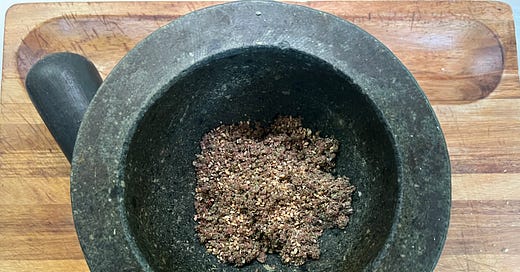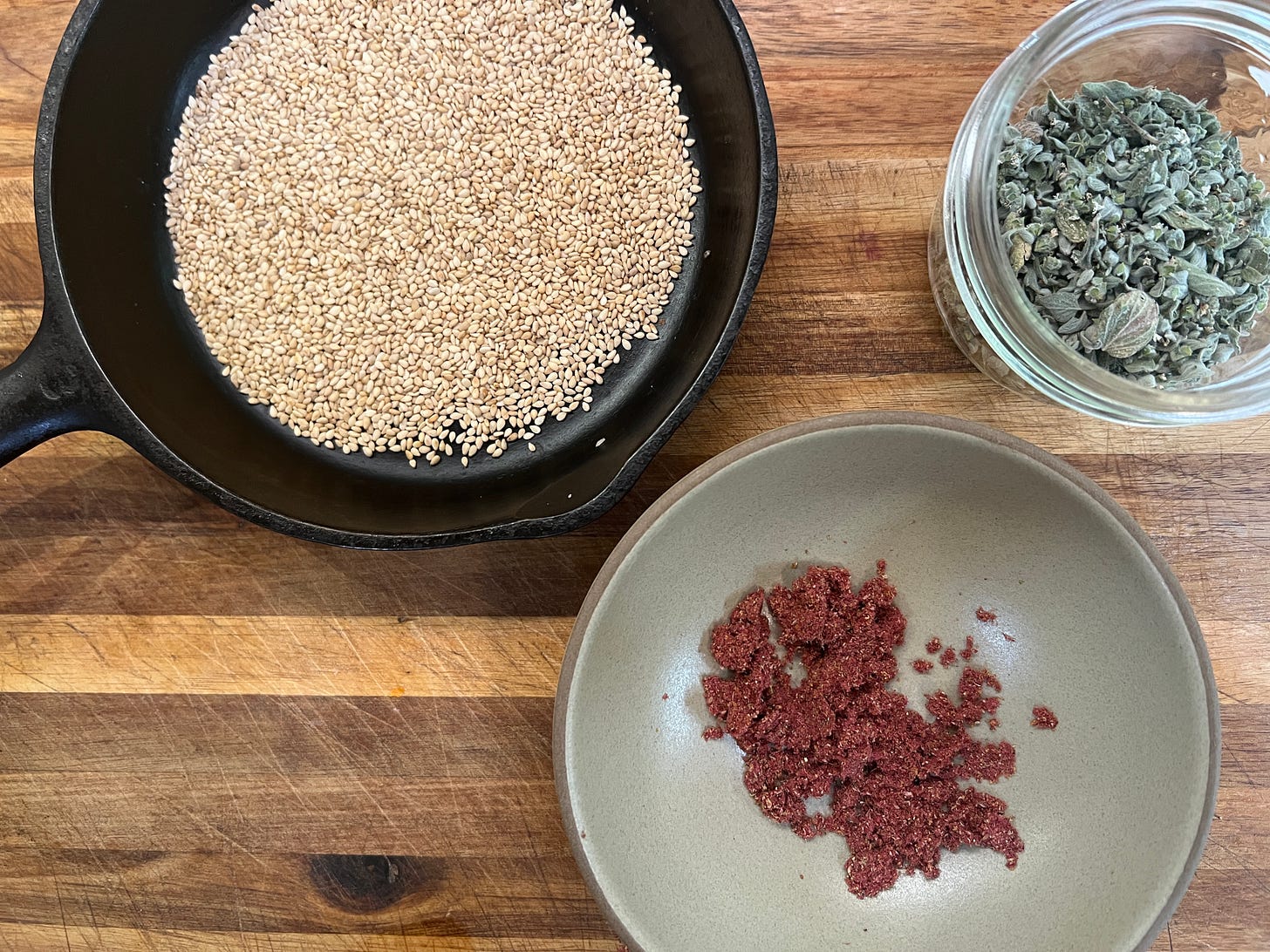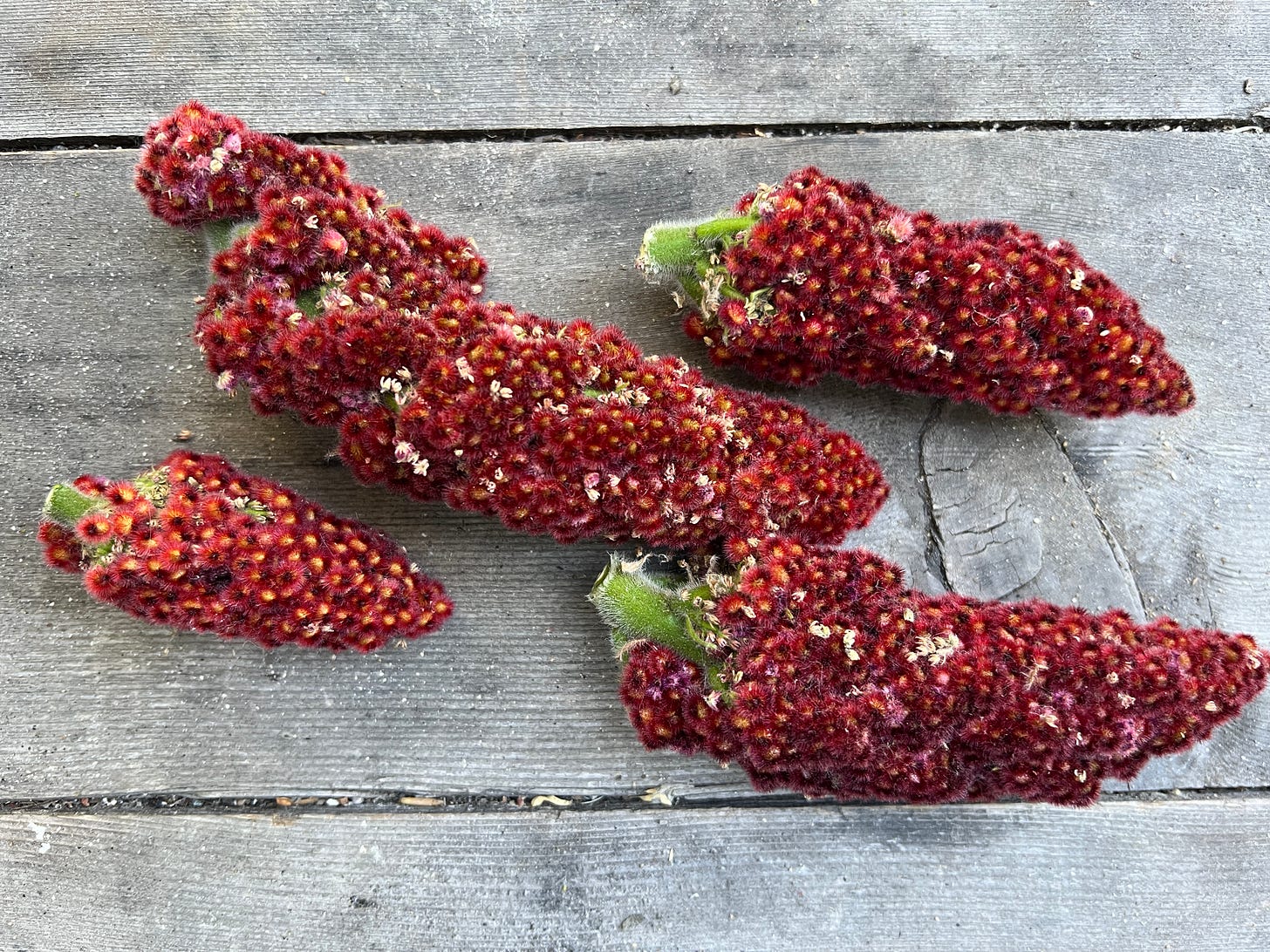Sometimes, you have to pursue an idea as far as you can take it. Even if it takes three years and some cyber stalking. Even if you probably won't do it again.
Which is to say, last week I finally made a batch of the Levantine herb blend za'atar from ingredients I grew and gathered.
A few springs ago, on one of our 60-bajillion trips to Portland Nursery, I picked up a small plant of a fuzzy, pale green herb labeled "za'atar marjoram." I had never seen za'atar growing on the stem.
The word "za’atar" refers to both an herb blend and its central ingredient, which is sometimes translated as “wild thyme,” sometimes “hyssop,” and sometimes identified as a variety of marjoram or oregano.
I have no idea whether the herb the nursery sold was even za’atar, or the right za’atar. Za'atar is gathered from wild spaces all across Jordan, Palestine, Syria, and neighboring countries. In Jerusalem: The Cookbook, the Palestinian-British chef Sami Tamimi recalls visiting family outside the city, when he would be sent out to gather scrubby, wiry za’atar plants growing between the rocks.
Depending on the region where you are eating za'atar, it may be Origanum syriacum, Thymbra spicata, Satureja thymbra, or a completely different species on the oregano-thyme-marjoram-savory continuum. Each za'atar belongs to its place.
Portland Nursery’s za’atar has been stripped of that sense of place, but it has become one of the herbs I use regularly. Less feral-tasting than the oregano that grows along our fence, this herb lends its resinous, savory flavor to my tomato sauces, my beans, and my tomato-cucumber salads.
Of course, I have made the za’atar herb blend with it as well, grinding dried herbs to mix with toasted sesame seeds and store-bought sumac, a tart, magenta spice made from the drupes (berries) of Mediterranean sumac trees. It is not my place to say whether my za'atar is better than the imported za’atar blends I have bought. I have enjoyed the way the herb blend smells so vivid in the palm of my hand, yet when I stir fistfuls of it into olive oil to brush across flatbreads, its flavors never bulldoze over those of the underlying wheat and yeast.
A few years ago, when we sheet-mulched over the lawn to replace the grass with drought-tolerant perennials and native wildflowers, I planted thyme, lemon verbena, savory, yerba buena, and za'atar around our little plum tree. With any luck, they would grow together into an aromatic carpet I could either roll around on or pick when dinner called. Someday, I hoped, perhaps I could grow enough za'atar to make pints of the herb blend to give away.
Turns out, the desert herb loves Portland’s dry summers but can't flourish in our clay-dense soils. It has not yet made it through a sodden winter. I have replanted za’atar twice in the yard, and it sputters along until the first frost kills it off. (A second patch in our herb box, rooted in looser soil, does better. If I clip it to the ground in October, it returns in the spring.)
The second challenge of making my own za’atar has been its other main ingredient: sumac. "Sicilian" sumac (as Europeans have labeled the Levantine variety, Rhus coriaria) is related closely enough to North American staghorn sumac (Rhus typhina) that other Americans have made the substitution. However, staghorn sumacs are not native to the West Coast.
Last year my plan was to try substituting dried, ground rose hips, which have a similar tart-fruit character. But the frost hit my rose bushes before the hips ripened. Dried, half-ripe rose hips, it turns out, taste like green tomatoes crossed with still-green raspberries.
This year, I messaged Heather Arndt Anderson — who writes OPB’s Emmy-winning “Superabundant” videos and weekly newsletter — after she posted an Instagram photo of some bright-red, conical sumac horns she’d gathered. Plenty of Portland homeowners plant staghorn sumacs as an ornamental, she told me.
So I searched for sumacs on the Portland Street Tree Inventory map — yes, this is easy to do, and no, I'm not going to tip my hand at the other edibles I'm cyberstalking. Then I dragged Christian around the neighborhood to spy on addresses where staghorn sumacs had been spotted. No luck. Chopped down. Too spindly. Too close to someone’s front door.
Weeks after I gave up, I spotted a flourishing sumac in Kenton. I wrote down the address, then mailed a postcard explaining my mission. The homeowner eventually texted me back to say I could take a few staghorns from the side of the bush that faced away from his front window. “We like to see the red rockets,” he wrote.
I snipped off 4 or 5 big horns, dehydrated them over the course of a few days. Following the 17 YouTube videos I watched, I scraped off the fuzzy red berries into a mesh strainer, than rubbed and rubbed them to separate the red stuff from the seeds.
The yield: One tablespoon of a fine, tart powder. Once I stopped thinking about all the work I had done to harvest one tablespoon of sumac, I realized that was perfectly fine, because the za'atar plants in my yard had only yielded about 3 tablespoons of dried herbs.
I ground together the sumac fluff, the dried za’atar, and some toasted sesame seeds, then stirred the mixture into olive oil to make a paste. Then I made Lebanese manakish, following Zaid Dough's recipe — if you've eaten at Reem's in San Francisco, you may know these breads as man'oushe, one of their Palestinian names. I had just enough of the aromatic, nutty, slightly tangy herb mix to slather over two rounds.
Was it worth it? Sometimes "Is this worth the effort?" isn't the question you should be asking yourself. Especially if you ramble on about how writing a free email newsletter is your way of opting out of the unexamined pro-capitalism underpinning most food journalism. Sometimes, a quest is simply a good excuse to replant an herb you like or to prowl around North Portland, inspecting your neighbors’ yards. Sometimes, making a tiny, delicious thing just once can be its own reward.










Greetings Jonathan! I grow za'atar, origanum syriaca version, every year from seed bought from Baker Creek seeds. It grows well for me, especially in pots so roots are warm. I dry a lot for winter use. Happy foraging!
Margaret in Port Angeles, WA
My gosh I love this, especially “is it worth it” not always being the right question to ask. (Signed, on year 8? of attempting back yard wasabi.)